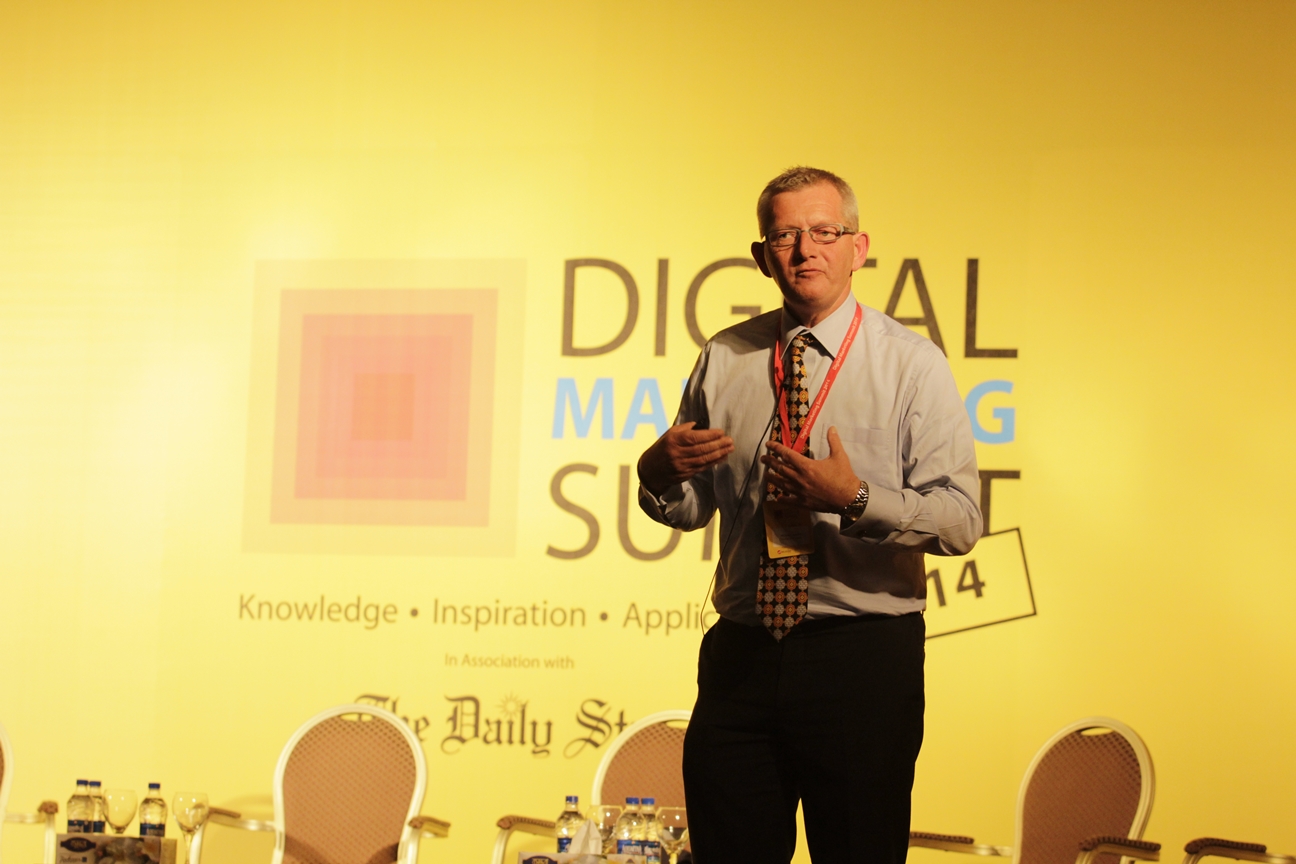Digital Marketing Summit 2014 in a Nutshell
Bangladesh Brand Forum organized its first Digital Marketing Summit in Dhaka on September 20, 2014, bringing together the brightest minds in the digital space. They shared their valuable insights about the elements of effective digital marketing and explored all the areas from mobile marketing to blogging and much more. Case studies and panel discussions with these brilliant personas took everyone through a fantastic journey into the digital world of marketing.
The session started with Manan Mehta, Sr. Vice President and Head of Business of Razorfish, India where he talked about the leading brands in social media. He pointed out how the trend on Facebook changed from likes to user engagement. That’s exactly how leading brands managed to yield success from their campaigns. He mentioned that brands should be able to converse with their audience in real-time, consider their opinions, and show them that their opinions are valued. He demonstrated examples of user engagement through videos of successful Digital Marketing Campaigns. Talking about how businesses should be tech updated, he debated the rationale of keeping digital in-house vs. hiring a digital agency. Even inside the organization companies should consider using internal social networks (such as Yammer) to engage their internal customers.
Following this session, the Co-Founder of NewsCred, Iraj Islam was given the floor to share his thoughts on digital marketing. Iraj Islam shared the success story of NewsCred and focused on the transition of marketing from traditional to digital. In his opinion two major changes took place. The first one is that the approach of marketing changed from interrupted marketing to interactive marketing. Interrupt marketing, which is essentially Push-marketing, disrupted people in their everyday lives and created a nuisance. Interactive marketing or Pull marketing engages with customers, discovers their needs, and makes the customers come to them. The second radical change that took place was the change in the customer journey. Customers are well informed and there are a few steps in the buying process of a customer. This led to the discussion on how content, when designed and placed intelligently, can influence the customers’ buying processes and guide them through their journeys. He described advertisements as a “bleep” in modern marketing. Marketing needs to change to a user story from a product story and show how products/services can help them solve their problems because customers only care about whether the product is going to solve their problems or not. The concept of marketing changed from being about numbers and figures to be all about people that a brand and agency can interact with. He infused storytelling into content marketing and talked about how it’s an essential element of content marketing.
Marketers are special. Because marketers are the caterers of the most special thing and that is storytelling. – Iraj Islam
He wrapped up his session by commenting that marketers need to be as competent in technology as they are in marketing. Ultimately if marketers don’t understand the technology, they can’t reach their customers.
Next came a panel discussion where the topic was mobile marketing. Drabir Alam, Associate Director of Cookie Jar moderated this session. Panel members included Kaymun Amin; Managing Director of VU Mobile, Nawbut Ali; Head of Marketing at Airtel, Tanim Ahmed; Head of Sales and Marketing of bdnews24.com, Hasan Mehdi; Head of Mobile of Samsung and Rakibul Hasan; General Manager at MediaVest Bangladesh. They talked about how far Bangladesh has come on mobile advertising and what improvements can be made in advertising through mobile. The Asia Pacific is the fastest-growing region in mobile marketing. But the most run-of-the-mill mobile marketing method of Bangladesh, bulk messages, seem irksome to most. Kaymun Amin considers a few approaches on how to make mobile marketing interesting. He emphasized the importance of target marketing when it comes to mobile advertising. To put it simply, if the message reaches the wrong audience it bears the risk of giving off a negative impression. Nawbut Ali deliberated further on how sharp targeting can measure and increase conversion. Since mobiles are the source of nearly 50% of the total traffic, Tanim Ahmed states the urgency of starting to monetize from this huge traffic.
Target marketing aims to get a good response by conveying the message to the right people. – Kaymun Amin
Now there are several essential elements for effective target marketing and Kaymun Amin points out a few. Depending on the campaign, it’s crucial to choose the right platform, the right content, and decide the basis of targeting (e.g. demography, location, etc.). The execution proves to be difficult if the advert agencies work alone. Mobile network operators also have a vital role in this. On that note, Hasan Mehdi voices that if mobile network operators and advertisers aligned and integrated their work, mobile marketing will advance by leaps and bounds.
The session advanced to another panel discussion; this time the point of the conversation was the current position of digital marketing in Bangladesh and what needs to be done to boost it further. Panel members were Ridwan Hafiz; Co-founder of Analyzen, Ovick Alam; Co-founder & CEO of WebAble, Shourav Islam; CEO of Unifox Digital Media, Riyad S.A. Husain; CEO of Magnito Digital and Sidrat Talukder; Managing Director of StrateGeek Digital Marketing. It started with a video presented by Ridwan Hafiz as he demonstrated user engagement in social media. In his opinion, if the content is designed to connect with the users, then it ensures that the campaign will go viral. Ovick Alam then shared his story of a successful Jaago campaign where he helped Jaago raise sponsors for a large number of children’s education by building a user-friendly micro-site. Following that, the panel addressed the question of what to do after an interaction is made.
The beauty of digital marketing is that you can track the interaction your content has with its audience. – Riyad S.A. Husain
What good would going digital be if we cannot utilize the valuable information it offers us? Ovick Alam pinpoints the need for a call to action for every digital campaign. Needless to say, Facebook is the heart of social media in our country. But Ovick Alam debates that Facebook is in fact not the central platform for digital marketing. There is no alternative to having a website where organizations have access to a copious amount of information about their visitors, customers, and potential customers.
Proper campaigning requires bringing people to your website where you can control what information you receive. – Ovick Alam
The discussion progressed to the basics of marketing and how the original principle is still the same; just how it is done is different. In this day and age, the experience is more important to the customers than the product itself. Riyad Husain stresses that instead of selling the product, the focus should be given to delivering the experience to the consumers. Sidrat Talukder wrapped up the session by expressing that digital marketing is not just advertising for the business, it’s how an organization is structured to keep up with the dynamic world.
After a hearty lunch, Shariful Islam, Founder & Editor Bangladesh Brand Forum, and WebAble’s Shadab Mahbub launched Bangladesh Brand Forum, a new publishing platform for Bangladesh.
Following the third and final panel discussion commenced, where storytelling was in the spotlight. The top bloggers of Bangladesh got together to share their stories and discuss the essence of storytelling and its impact on people using social media. Panelists participating in this session were Bloggers Camelia Kamal, Arif R Hossain, Chowdhury Shaheb, and Rajib Hasan. The session was moderated by Razeeb Hasan Chowdhury; COO of Ogilvy Bangladesh. Each blogger had a unique style of communicating with their audience. The members shared tips and tricks on enabling user engagement via likes and shares and connecting with people. The session ended with Arif R Hossain showing an inspiring video on how one small step from an individual can make a difference.
This brings us to the final session and the highlight of the event where keynote speaker Michael Leander discussed the elements to create a successful digital marketing campaign. Here he sheds some light on why digital marketing campaigns fail, tips to make a campaign go viral, and how to get the best return from marketing investment. Even though we see campaigns and videos going viral every other week, the truth is 9 out of 10 campaigns do not go viral. Michael Leander pointed out a few reasons why digital campaigns fail and it happens mostly due to misconceptions, miscommunications, and poor decisions taken by the marketers. Marketers desperately try to reinvent the wheel, which results in their campaigns’ downfall. The keys to making a campaign go viral, as stated by Leander, is to think about the various types of audience it aims to appeal to, to minimize the friction so it’s easier for people to access it and not just go with the flow without considering the context.

Having said that, Michael Leander moved on to content marketing and inbound marketing. Pictures leave a lasting impression on people’s minds and they can only be effective if the message can be placed properly. Along with pictures, words have an impact on consumers. Michael Leander demonstrated how we could change the world through our words with a touching video.
Don’t count the customers you reach. Reach those who count. – Michael Leander
Discussing the change in views on marketing he said the way adverts talk to people is not a way people want to be communicated with. We need to speak their language through our content to truly reach out to them. To get the best return on marketing investments marketers need to stop marketing and start listening. They should respond to all opinions, be it positive or negative.
If you talk to people the way advertisements talk to you, they might punch you in the face. – Michael Leander
Michael Leander also shared his insight on website structures so that they can be used to their full potential. A website needs to separate its target personas and create a clear path for navigating each of them. It needs to focus on usability and conversion paths. To get the most conversion it has to be designed in a way that makes it easy to understand to the potential consumers, and they know where to go next with ease.
To end the wonderful session, Michael Leander emphasized that an ample amount of time needs to be spent on training the employees.
With a few inspiring words, the session was wrapped up and the Digital Marketing Summit came to an end. The amazingly diverse personalities and their views captured the audience and gave them a lot to think about. Safe to say, everyone will be looking forward to the next time such an enjoyable and enlightening event takes place.






